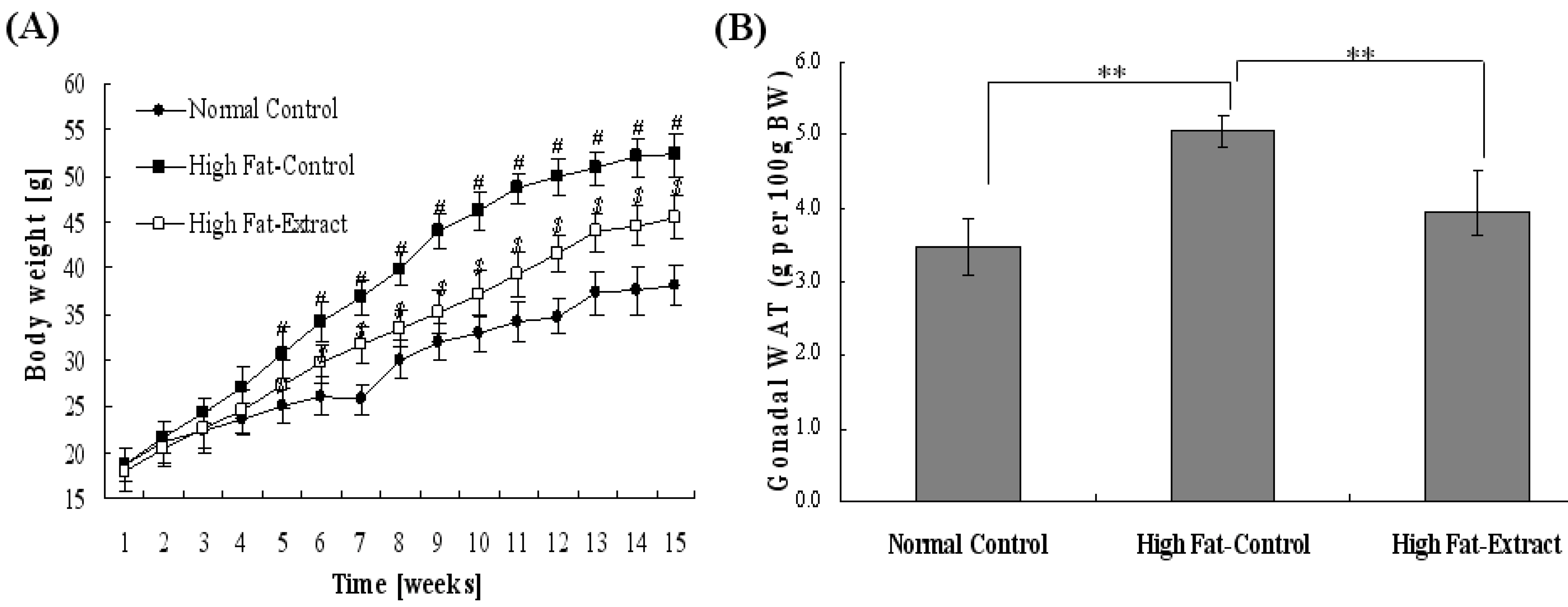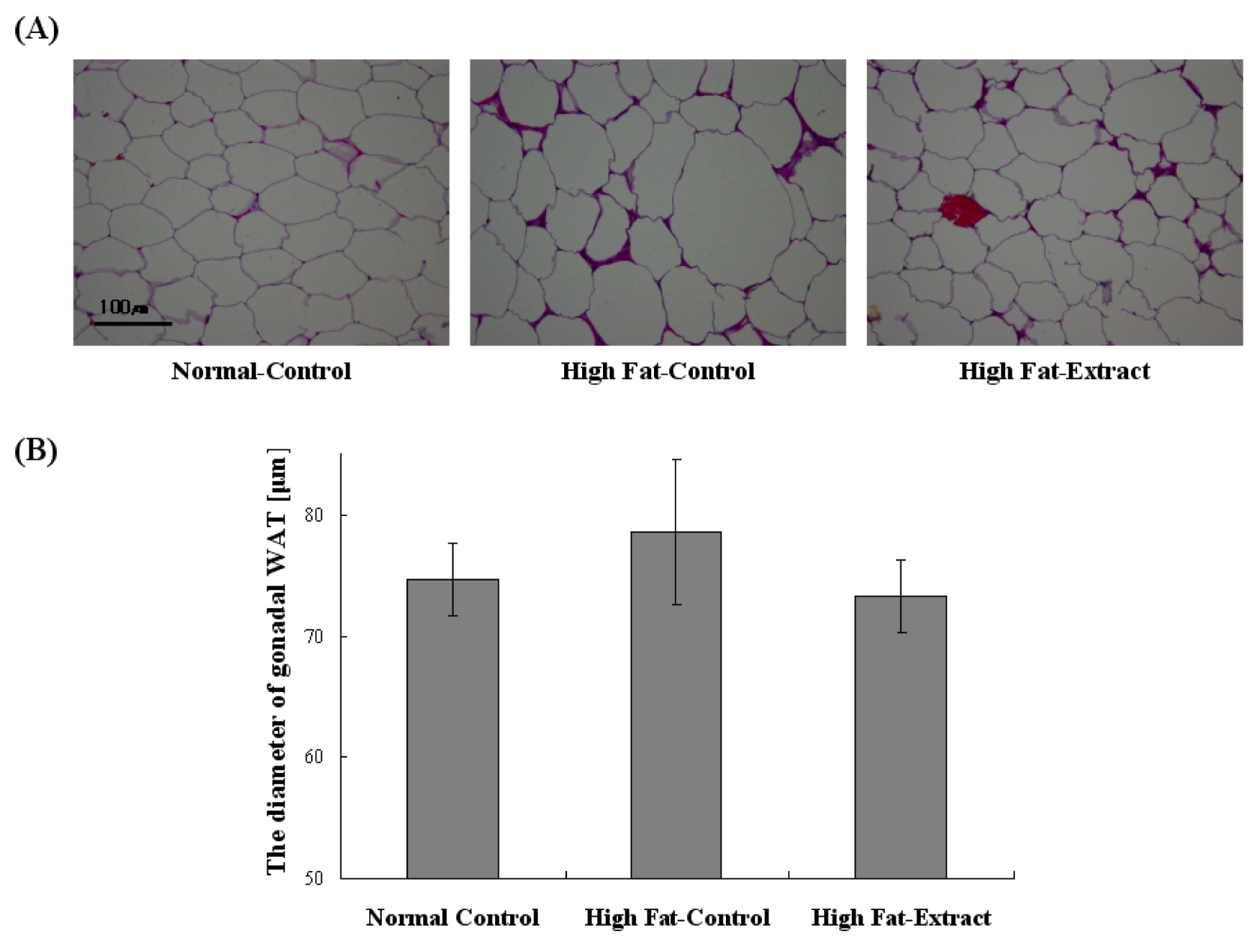1. Introduction
Obesity is a chronic metabolic disorder caused by an imbalance between energy intake and expenditure. High weight and obesity are defined as abnormal or excessive fat accumulation presenting a health risk. Obesity is a global health problem. Obesity is closely associated with life-style-related diseases such as atherosclerosis and non-insulin dependent diabetes mellitus and with increased risk of coronary heart disease [
1,
2,
3,
4]. The World Health Organization (WHO) estimates that the number of overweight adults will balloon to 2.3 billion (over 10% of the world’s population) by 2015, which is equal to the combined populations of China, Europe, and the U.S. In spite of many efforts to reduce body weight, the obese population has been continuously growing [
5,
6,
7,
8]. Many scientific communities have become increasingly interested in the molecular regulation of triglyceride synthesis and in pharmaceutical approaches to reduce fat absorption and storage due to phytochemicals, presenting an exciting opportunity for the discovery of newer anti-obesity agents [
9,
10,
11,
12,
13,
14]. Thus, new safer and more effective anti-obesity drugs are needed. The discovery of bioactive compounds from diet or dietary supplementation is one possible way to control obesity and prevent or reduce the risks of getting various obesity-related diseases. Recently, many scientists have reported that the anti-obesity agents from natural products are a promising field to approach the solution to a global health problem such as obesity [
15,
16].
Nepeta spica, one of Labiatae family, can be found in many parts of the Asia. In Korea,
Nepeta spica has been used as food additives, seasoning ingredients, traditional medicines for a wide variety of ailments including anxiety, indigestion, bronchitis, and insomnia, especially accompanied by chills and fever, and nervous tension [
17,
18]. Although some constituents of Nepetae spica have been identified, there have been few studies on the anti-obesity effect of a crude extract for proving its pharmacological activities. To the best of our knowledge, this is the first report showing that Nepetae spica extract demonstrates the anti-obesity activity.
2. Experimental Section
2.1. Materials
Nepetae spica was purchased from Deokhyeon-dang (Kyungdong market, Seoul, Republic of Korea). All reagents were of the highest grade available. The dried Nepetae spica was heated three times with distilled water, and the extract was obtained through the removal of the water during evaporation. It was then freeze-dried to obtain the extracts. The samples were stored at −20 °C for further study.
2.2. Mice and Diet
C57BL/6 female mice were used in the present study. Young mice (6 weeks of age) were purchased from Orient Bio Co., Ltd. (Charles River Technology, Songham, and Republic of Korea). The mice were housed 5–10 per cage under specific pathogen-free conditions at 23 °C ± 3 °C and 50% ± 10% relative humidity, and were provided with nutritional chow 5L79 (PMI Nutrition LLC, St Louis, MO, USA). The mice were given free access to water and were fed on a standard diet and a high-fat diet for 15 weeks. The experimental group was orally administrated with Nepetae spica extract at a concentration of 200 mg kg
−1 body weight for 15 weeks. The composition of diets and fat ratio are shown in
Table 1 and
Table 2. These experiments were approved by the Korea Laboratory Animal Care and Use Committee. All procedures were conducted in accordance with the ethical guidelines in the “Animal Care Act”, prepared by the Ministry of Agriculture and Forestry, Republic of Korea.
Table 1.
Composition of the diets.
Table 1.
Composition of the diets.
| Composition (g/kg) | Normal | High-fat |
|---|
| Casein | 200 | 200 |
| L-Cystine | 3 | 3 |
| Corn Starch | 315 | 0 |
| Maltodextrin 10 | 35 | 125 |
| Sucrose | 350 | 68.8 |
| Cellulose, BW200 | 50 | 50 |
| Soybean Oil | 25 | 25 |
| Lard | 20 | 245 |
| Mineral Mix S10026 | 10 | 10 |
| DiCalcium Phosphate | 13 | 13 |
| Calcium Carbonate | 5.5 | 5.5 |
| Potassium Citrate | 16.5 | 16.5 |
| Choline Bitartrate | 2 | 2 |
Table 2.
The fat ratio of diets.
Table 2.
The fat ratio of diets.
| Ratio (%) | Normal | High-fat |
|---|
| Protein | 19.2 | 26.2 |
| Carbohydrate | 67.3 | 26.3 |
| Fat | 4.3 | 34.9 |
| Diet (kcal/g) | 3.85 | 5.24 |
2.3. H&E Staining and Biochemical Assay
For hematoxylin and eosin (H&E) staining, the samples were fixed in 10% formalin, prepared as paraffin blocks, sectioned at 6 μm, and stained with H&E. The prepared specimen was examined using a light microscope at 100× magnification. To measure the biochemical analysis in serum, the animals were deprived of food for 15 h, and blood samples were then collected from the veins of the mice under carbon dioxide anesthesia. Triglyceride concentration was measured enzymatically using commercial kits and following the manufacturer’s procedures (ASAN Pharm. Co., Seoul, South Korea). T-cholesterol in serum was measured through an enzymatic colorimetric method using a commercial kit (ASAN Pharm. Co., Seoul, South Korea).
2.4. Statistics
A statistical analysis was performed using a one-way analysis of variance (ANOVA). The values are expressed as average ± standard deviation. The p values as 0.05 or 0.001 were considered as significant.
3. Results and Discussion
The composition of the diets was presented in
Table 1. And it was compared to the fat ratio of diets in
Table 2.
Figure 1A represents the changes in body weight of the groups during the experiments. Feeding a high-fat diet containing Lard caused a marked increase in body weight as compared to a normal diet. However, feeding a high-fat diet plus Nepetae spica extract at levels of 200 mg/kg body weight significantly reduced the body weight gain induced by the high-fat diet (
Figure 1A). Food intake during the experiments was weighed. Feed intake was measured twice a week, where normal diet group had a higher feed intake compared to high fat diet group, though there was not any significant difference between control and Nepetae spica extract treated groups after 15 weeks.
Figure 1.
Effect of Nepetae spica supplementation on body weight in C57BL/6 fed high-fat diet. Values are means ± standard deviation (n = 9 per group) #, p < 0.05 vs. normal diet. $ p < 0.05, high fat-extract vs. high-fat diet (A) and gonadal white adipose tissue (gWAT) in organ. Values are means ± standard deviation (n = 9 per group), ** p < 0.001 normal diet vs. high fat diet, high fat-extract vs. high fat diet (B).
Figure 1.
Effect of Nepetae spica supplementation on body weight in C57BL/6 fed high-fat diet. Values are means ± standard deviation (n = 9 per group) #, p < 0.05 vs. normal diet. $ p < 0.05, high fat-extract vs. high-fat diet (A) and gonadal white adipose tissue (gWAT) in organ. Values are means ± standard deviation (n = 9 per group), ** p < 0.001 normal diet vs. high fat diet, high fat-extract vs. high fat diet (B).
In
Figure 1B, the effects of Nepetae spica extract on gonadal white adipose tissue weight in mice fed a high-fat diet for 15 weeks were investigated. The mice fed a high-fat diet containing lard for 15 weeks have a significantly higher adipose tissue weight than mice fed a normal diet. The treatment of Nepetae spica extract significantly reduced the adipose tissue weight to 1.5 per100 g body weight in high-fat mice.
When the adipose tissue morphology was investigated for histochemical staining, the distribution of cell size in the high-fat diet groups was hypertrophied compared with those from Nepetae spica extract-treated mice (
Figure 2A). Quantification of adipocyte size confirmed the distribution of cell size with mean diameters decreasing from 79 ± 6 μm in the high-fat diet groups, and to 72 ± 3 μm in the Nepetae spica extract-treated groups (
Figure 2B). The serum triglyceride and T-cholesterol level were higher in the high-fat diet alone group than in the normal diet group. In Nepetae spica extract-treated mice (
Figure 3A and
Figure 3B), a significant reduction of serum triglyceride and T-cholesterol was observed at to 13% and 16%, respectively. In this study, we have shown that Nepetae spica extract had such anti-obesity effects as reducing the body fat mass and body fat percentage in mice fed with a high-fat diet. Furthermore, Nepetae spica extract showed T-cholesterol and triglyceride lowering effects in mice fed with a high-fat diet.
Figure 2.
Effect of Nepetae spica extract on gonadal white adipose tissue (WAT) in high-fat diet mice (A) Histological analysis of WAT from control and high-fat diet and Nepetae spica treated high-fat model; (B) Average gonadal WAT morphology.
Figure 2.
Effect of Nepetae spica extract on gonadal white adipose tissue (WAT) in high-fat diet mice (A) Histological analysis of WAT from control and high-fat diet and Nepetae spica treated high-fat model; (B) Average gonadal WAT morphology.
Figure 3.
Effects of Nepetae spica extract treated on body weight in C57BL/6 fed high-fat diet (A) Triglyceride. Values are means ± standard deviation (n = 9 per group) ** p < 0.001 vs. normal diet; * p < 0.05 high fat-extract vs. high fat diet; (B) T-Cholesterol. Values are means ± standard deviation (n = 9 per group) * p < 0.001 vs. normal diet; * p < 0.05 high fat-extract vs. high fat diet.
Figure 3.
Effects of Nepetae spica extract treated on body weight in C57BL/6 fed high-fat diet (A) Triglyceride. Values are means ± standard deviation (n = 9 per group) ** p < 0.001 vs. normal diet; * p < 0.05 high fat-extract vs. high fat diet; (B) T-Cholesterol. Values are means ± standard deviation (n = 9 per group) * p < 0.001 vs. normal diet; * p < 0.05 high fat-extract vs. high fat diet.
4. Conclusions
In summary, we showed that Nepetae spica extract had such anti-obesity effects as reducing the body fat mass and body fat percentage in C57BL/6 fed a high-fat diet. The distribution of cell size in the high-fat diet groups was hypertrophied compared with those from Nepetae spica extract-treated mice. Furthermore, Nepetae spica extract significantly showed triglyceride and T-cholesterol-lowering effects with the same diet. In light of such beneficial effects, Nepetae spica extract has potential use as a functional nutrient for preventing lifestyle-related obesity diseases in humans who tend to ingest a diet containing a high level of fat. Consequently, Nepetae spica extract is expected to create therapeutic interest with respect to the treatment of obesity. However, further work is needed to elucidate the possible mechanisms by which Nepetae spica extract intervenes.








